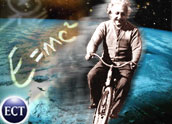
Scientists have found direct evidence that massive objects in space do pull the space surrounding them, a phenomenon called “frame-dragging” that was first predicted in 1918 using Einstein’s theory of general relativity. The findings were reported in the journal Nature.
Einstein believed that massive objects such as the Earth pull the space and time around them as they move, creating distortion. This distortion, in turn, creates Earth’s gravitational pull. Any smaller objects near the distortion would also shift.
“There were two remaining tests for Einstein’s General Relativity (GR) theory: The test that we have reported results on in the latest issue of Nature, and the detection of gravitational waves,” geodesist Erricos C. Pavlis of NASA’s Goddard Space Flight Center in Greenbelt and the University of Maryland at Baltimore, explained to TechNewsWorld.
“The latter will be tested (bar any surprises), by the NASA mission LISA/LIGO which will launch sometime in 2010 or so. The former has been our pet investigation for several years.”
Orbit Variation
Pavlis and research partner Ignazio Ciufolini of Italy’s University of Lecce tracked the orbits of LAGEOS and LAGEOS2 (Laser Geodynamics Satellites), which were designed to have very stable orbits to allow precise measurements of distance from the station to the satellite.
The researchers found that the satellites’ orbits were slightly different from what they should have been. The variation proved frame-dragging exists, they said.
“These results were made possible by the excellent products (gravity models) that are coming out of the NASA mission GRACE,” Pavlis explained. “The results were based on laser ranging data collected and freely distributed by the International Laser Ranging Service, with minimal effort by our team — beyond what we normally have to do for other applications of these data.”
Pavlis and Ciufolini had published results with a 20 percent margin of error in the journal Science in 1998. A NASA mission now in orbit, Gravity Probe B, is scheduled to observe “frame-dragging” in about a year. It is expected to be accurate to within 1 percent. Pavlis and Ciufolini’s results are accurate to about 5 percent.
“The more such results, and the more independent confirmations, the better,” Pavlis said.
Measuring Gyroscope Spin
Gravity Probe B measures tiny changes in the direction of spin of four gyroscopes contained in an Earth satellite. This allows for the measurement of how space and time are warped by the presence of the Earth, and of frame-dragging.
“We will continue our work with the two satellites we used, extending the test in time, and eventually using background models that are even of higher resolution and accuracy, as they become available in the future, to produce an even more accurate result,” Pavlis said.





















































